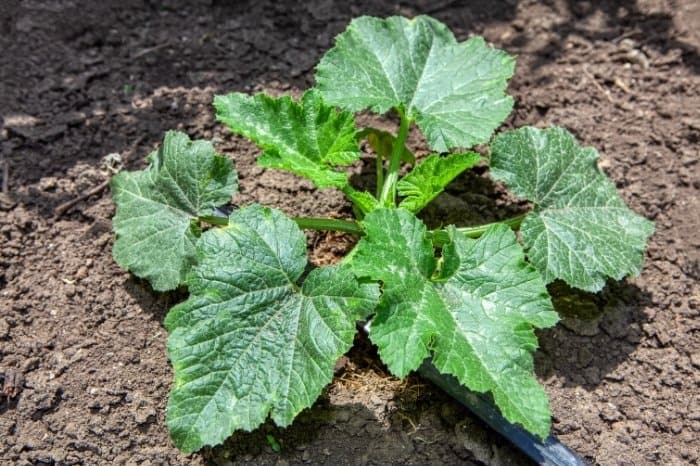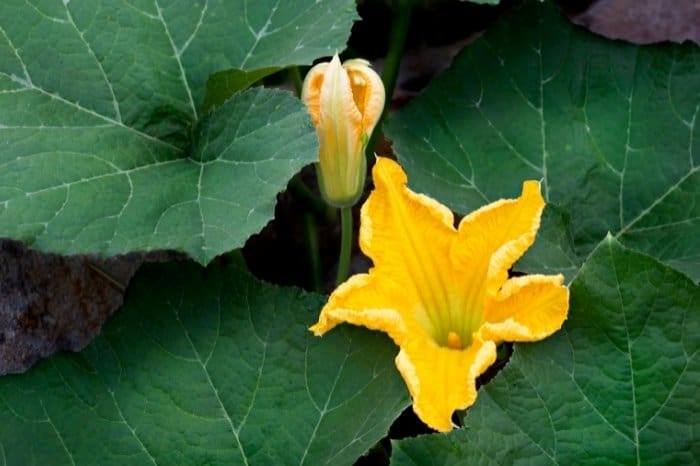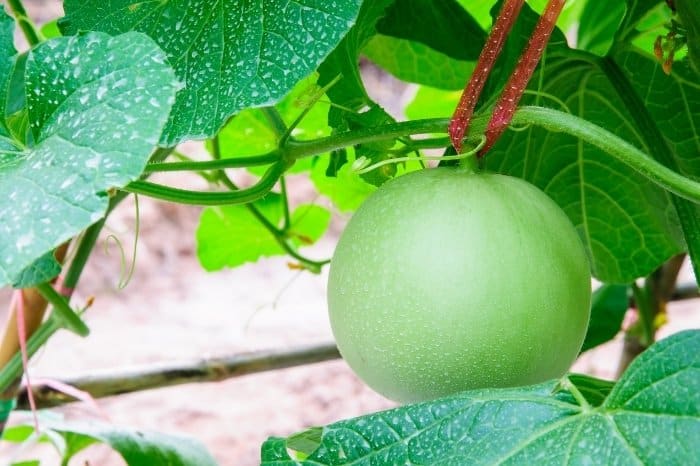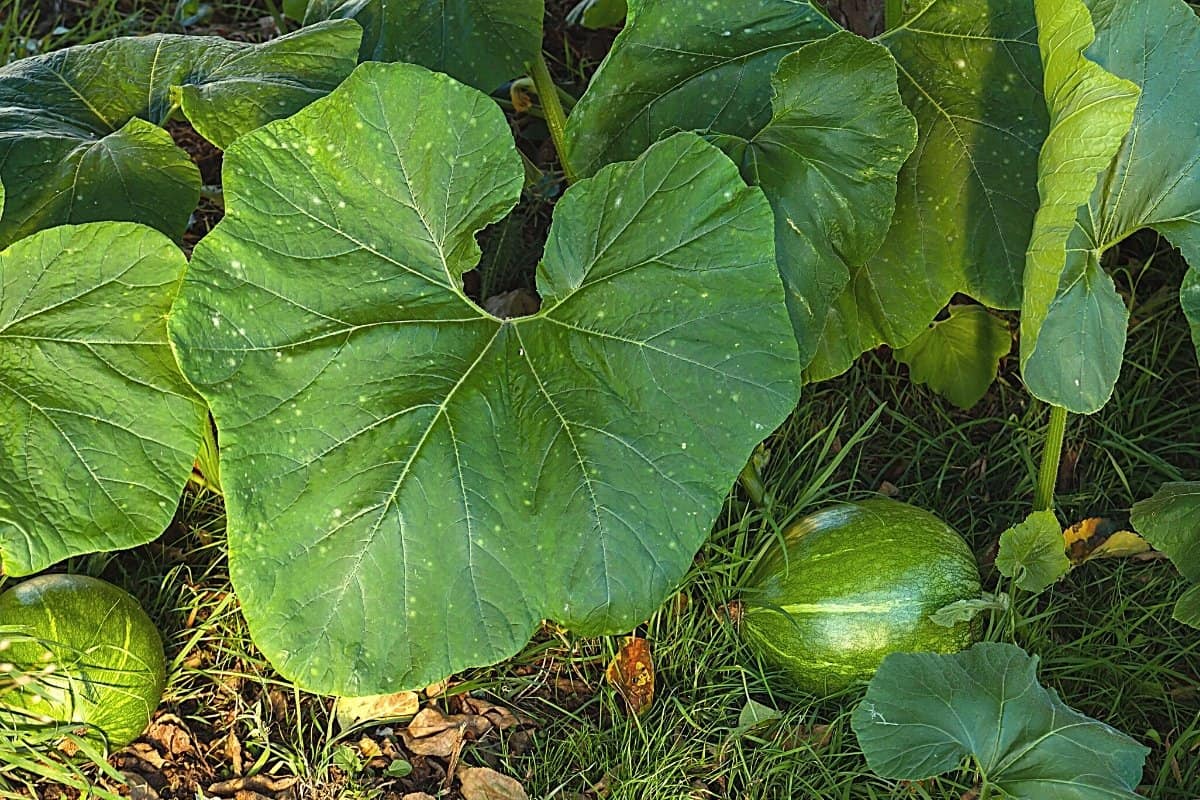Last Updated on June 21, 2023 by Tony Manhart
Identifying squash plants by leaves is easy if you know what the leaves look like but if you don’t, read this article to get some info.
Squash is the collective name that stands for several species of plant in the Cucurbita genus that includes the C. Moschata, C. Maxima, C. Mixta, and C.Pepo. These are all widely grown for their renowned fruit loved worldwide.
They originate from North and Central America and are named according to their cultivar name. For example butternut squash, acorn squash, spaghetti squash, zucchini, buttercup squash, and banana squash.
Squash are herbaceous plants that are either trailing vines or bush-like morphology. The vines have large lobed leaves and long vines that can climb by attaching themselves to surfaces with their tendrils. The bushes take up less space than the trailing vines and have prickly leaves.
Squash plants produce orange or yellow flowers and green, yellow, or white fruit in a variety of shapes and sizes with ridged or smooth skin.
Vining squash is an annual that survives only one growing season growing up to several meters in length.
Characteristics Of Squash Leaves
Most gardeners can identify a squash plant by its leaves but if you can’t we are here to help. Did you know all squash plant leaves look similar with the same characteristics? Taxonomists have classified the leaves of squash in three different ways. They include
-
Squash leaves have an alternate leaf arrangement on stems
-
They are exstipulate
-
These leaves have simple palmately compound shapes or are palmately lobed.

How To Do A Squash Leaf Identification?
We will look into all the different species of squash.
Maxima
-
Its leaves are plain and smooth.
-
The flowers are smallish and rounded.
-
The stem is cork-like and round.
-
Its mature fruits are orange, green, or peach while immature ones may be yellow.
-
The fruit grows up to thousands of pounds
-
It is round, blocky, or elongated
-
The fruit is no necked squash
-
It has large to extra-large seeds
Moschata
-
It has smooth leaves often mottled
-
Have rounded flowers
-
Its stem has 5 sides and is flared where it connects with squash
-
The ripe fruit of this type is tan
-
Immature flowers are light green, dark green, or buff
-
The fruit grows up to 30 pounds
-
The fruit shape is elongated, blocky, or necked
-
It has small to medium seeds – often with a dark margin

Pepo, Oaxacan
-
It has deeply indented leaves that are sharply toothed
-
The leaves are
-
Has flowers with a fat star shape
-
Its stem is 5 sided, star-like, and very angular
-
The fruits are green, yellow, orange, buff, or white.
-
They weigh up to 30 pounds
-
The fruit is round, elongated, or blocky
-
The seeds are flat and large
Pepo, Atlantic
-
The leaves of this Pepo Atlantic and the Oaxacan are the same
-
Both species have a wide range of leaf shapes
-
They can either be spiky like the Zucchini with more rounded features
-
Fruits are green, white, and yellow
-
They weigh about 5 pounds
-
The fruit is elongated, blocky, round, or necked.
-
It has small seeds

Mixta
-
It has a jagged leaf margin and is sometimes deeply lobed or heavily mottled
-
The flowers are star-shaped with petals rolled up
-
The stem is cork-like
-
Its fruits are yellow, orange, white, and green
-
The fruits are necked and roundish
-
They weigh 15 pounds
-
The seeds are large with the skin often cracked
What Else Do Squash Leaves Tell The Gardener?
Identifying squash plants by leaves is the first step to knowing what plants you have in your garden. However, it also helps you know the condition of your plant. Squash leaves can help you know:
-
The Health Status Of The Plant. Squash leaves can tell when the plant is not doing too well. These leaves are like thermometers alerting the gardener to potential health issues. Discolored leaves are an indicator to watch out for because it depicts stress.
-
The Temperature. Squash leaf edges will turn olive green to brown with sudden temperature drops. This occurs if the temperature goes below 50 degrees F or the soil temperature is lower than 62 degrees F.
If you are curious about butternut squash, check out the following video:
Diseases And Pests
-
Powdery Mildew. To notice this mildew you will need to look at the old leaves of a squash plant. When you notice, yellow spots know that powdery mildew has formed. Besides the yellow spots, you will see a white-to-gray powder that you can see and feel on the leaves. If you don’t treat it, it can kill your plants.
-
Downy Mildew. Affected leaves will develop pale green to yellow spots on the upper side. The leaves will also turn brown and purple on the underside if they are in an environment of high humidity.
-
Squash Bugs. Bugs are a common pest to attack squash plants. The dark brown adult and the smaller gray nymphs cause the yellowing and wilting of squash leaves.
-
Squash Vine Borer. The squash vine borer is the most dreaded pest on the squash plant. It feeds on the plant and causes yellowing and wilting of the leaves.
-
Bacterial Wilt. The bacterial wilt causes the leaves to appear dull green and wilt all day but recover at night. Soon after the leaves will die.
-
Spider Mites. The 1/50-inch-long pest is terrible when it gets to squash plants. It makes the leaves appear pale and stippled. If heaving is infested, the leaves can be the webbed underside.
-
Viruses. Mosaic viruses are common and irregular blotchy to wavy mosaic patterns on the leaves causing shades of yellow or green on squash leaves. The leaves end up distorted, curled, and wrinkled.
-
Aphids. Aphids are the dreaded pests on your squash because they multiply fast and affect the plants very fast. These tiny soft-bodied cause leaves to turn yellow and wilt. These can transmit viruses as well as devastate the plant further.
AgroMagen, GrowSafe Bio-Pesticide, Organic Natural Miticide, Fungicide, and Insecticide, Non-Toxic
How Do You Tell The Difference Between a Cucumber and a Pumpkin Plant?
If you’re wondering how you tell the difference between a cucumber and a pumpkin plant, then the following information will give you the answers. Telling these plants apart is quite simple. All you need to do is monitor their growth and take heed of their leaves. This is because, if you look at cucumber leaves, their particular structure includes triangular-shaped leaves with flat centers.
Cucumber leaves are also quite rough to the touch compared to pumpkin plant leaves. When it comes to pumpkin plants, you should note that there are a variety of species that come in different shapes and sizes. However, their leaves are much bigger than cucumber plants and they have between three and five lobes. If your plant has elongated serrated foliage, then you should know that you’re growing zucchini squash and not cucumber.
How Do You Tell The Difference Between a Pumpkin and a Watermelon Plant?
Ever thought about how you tell the difference between a pumpkin and a watermelon plant? Well, these plants have very similar foliage and seedlings and it can be difficult to tell them apart if you don’t know what to look for. This is because both plants have elongated spiraling vines that their fruit grows from and their seeds are almost identical. However, when they grow and mature, there are some noticeable differences in the appearance of their leaves.
If you examine them closely, the first notable difference is in the shape of their lobes. While pumpkin leaves have pointed peaks, watermelon plant leaves are rounded. A good comparison would be oak and maple plants because while watermelon leaves resemble the former, pumpkin plants on the other hand look much more like the latter. Additionally, the size of these plant leaves is also another telltale sign in telling them apart. This is because pumpkin leaves are twice the size of watermelon leaves.
Why Do My Squash Leaves Have White Veins?
Why my squash leaves have white veins is a question that we are often asked by gardeners from around the world. There is no straight answer to the question as the reason for the appearance of the white lines on your plant leaves may vary. However, you should check all the suggestions to tick off the boxes and get to the root of the cause. Firstly, white veins on your squash leaves could mean a nutrient deficiency, unsuitable growing medium, over or underwatering, or larvae that can develop into an insect infestation.
Overly acidic soil should be amended if you find that this is the cause of the white veins on your squash plants. Check to see if your plant is wilting in this case as it will indicate whether its health is deteriorating or it is receiving an inadequate amount of water. Also, white veins on squash leaves can be due to root rot which is essentially due to too much of water or a growing medium that does not drain well. If you notice that your squash plant leaves have white veins, it is best to give them the proper care to avoid further deterioration and sid them growing healthily.
Squash Identification Conclusion
Now that we have learned an easier way to help in identifying squash plants by leaves, flowers, and fruits we can go ahead and grow them.
To prevent your plant from pests and diseases as we have seen above, keep your squash healthy through proper feeding, watering, and growing at the right spot in your garden. Then you will reap a good harvest and enjoy your squash with your loved ones.
FAQs
How can I know if I have a squash plant?
The easiest way to tell if you have a squash plant is to pull up the leaves. Squash plants will have leaves that are large and round or oblong shaped. There will be four leaves on each side of the stem. If you see a small leaf with a pointy tip, that’s a pumpkin vine.
How do I know what kind of squash plant I have?
The leaves of all these plants are similar in shape and texture, with long, narrow blades that have serrated edges.
You can tell which type of squash you have by looking at the leaves on your plant. The leaves will be either pointed or round. The pointed leaf type is called zucchini, and the round leaf type is called summer squash.
How do the leaves grow at first?
The first year they will come up as a small, greenish-white stem with several leaves and will flower in late spring to early summer.
Squash leaves eventually develop 3 lobes and they are all similar in size. The first and second lobes have smaller, darker, veins that run parallel to the center vein of the leaf. The third lobe is wider than the others and has no dark veins.
Why is identifying your squash important?
If you are looking to grow squash, you need to know what kind of squash you are growing. Squash plants come in many different varieties and each variety has its own look, feel and taste. Knowing the differences between these varieties will help you grow your best crop.
Squash are a family of plants that include the summer squashes (including zucchini, pumpkin and yellow crookneck), the winter squashes (including butternut, Hubbard and acorn) and the tropical summer squashes (such as the calabash).
How can you tell the difference between squash leaves?
Squash leaves are very easy to recognize, even if you’ve never seen them before. All leaves of a squash plant have two main veins running down the middle of their leaves. The top vein is the “petiole,” and the bottom vein is the “rachis.” A rachis is usually thick and has more than one leaf on it. Squash plants grow in a variety of shapes, including long, skinny vines with many leaves; squat, thick vines with only one leaf per node; or sprawling, bushy plants with many leaves.
How can you tell the difference between squash and zucchini leaves?
The leaves of squash plants are typically smaller than zucchini plants, but the flowers are usually similar in size. The squash ones are more narrow and pointed, whereas the zucchini ones are broader and not as pointed. Squash leaves are usually thinner and have a more pointed tip, whereas zucchini leaves are often thicker and have a rounder tip. Squash leaves will have some amount of thorns and/or spines on the edges, as well as long leaf hairs. Zucchini leaves will have fewer of these.
Do squash have tendrils?
You probably mean "tendrils" as in the root that sprouts from the side of the plant. That is something all plants have. So the answer is yes, they have tendrils.
Caroline is a gardener who loves to get down to the nitty–gritty of gardening. She proudly proclaims herself as a ‘dirt worshipper‘ and can often be found deep in the garden, covered in soil and singing to her plants. As a self–proclaimed ‘plant whisperer‘, Caroline believes that plants need love and attention just like any other living thing, and she loves to give them both. When she‘s not tending to her garden, you can often find her researching the latest gardening trends, or teaching others how to make their gardens thrive



